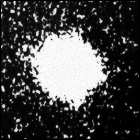 Astronomer James Christy, conducting observations of Pluto at the United States Naval Observatory, discovers a bulging shape present in some photos he’s taken of Pluto, but absent in others. Though the find meets with some skepticism, he has discovered the largest moon of Pluto, Charon, which has a mass of over 50% that of its parent body. Orbiting at only 11,000 miles from Pluto’s surface, Charon has a radius of 750 miles. Within 20 years, closer telescopic examination (including observations using the Hubble Space Telescope) confirm that Charon is separate from Pluto. Since the two bodies are relatively similar in mass, one doesn’t actually orbit the other; rather, they both orbit a center of mass – a barycenter – that lies close to, but not within, Pluto. Further observations in the 21st century lead to the unexpected discovery of four further satellites of Pluto.
Astronomer James Christy, conducting observations of Pluto at the United States Naval Observatory, discovers a bulging shape present in some photos he’s taken of Pluto, but absent in others. Though the find meets with some skepticism, he has discovered the largest moon of Pluto, Charon, which has a mass of over 50% that of its parent body. Orbiting at only 11,000 miles from Pluto’s surface, Charon has a radius of 750 miles. Within 20 years, closer telescopic examination (including observations using the Hubble Space Telescope) confirm that Charon is separate from Pluto. Since the two bodies are relatively similar in mass, one doesn’t actually orbit the other; rather, they both orbit a center of mass – a barycenter – that lies close to, but not within, Pluto. Further observations in the 21st century lead to the unexpected discovery of four further satellites of Pluto.
Tags:
Categories
Comments are closed